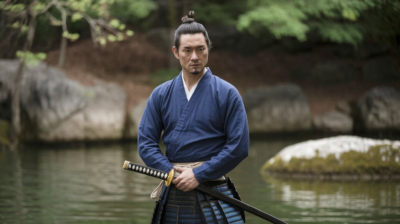Blog
How to Carry a Katana on Your Back: A Comprehensive Guide

The katana, an iconic Japanese sword, holds deep historical and cultural significance, particularly in relation to the samurai and ninja. Different warriors carried the katana in ways that reflected both practicality and symbolism. Highlighting the contrasting needs and values of the two classes.
The Samurai and the Katana: Tradition and Symbolism
The Katana as an Extension of the Samurai
More than just a weapon for the samurai, the katana represented his rank, glory, and severity of self-control. Samurai katanas hung at their waists under the sashes called obis. The blade position edge up was particularly clever for the speed and accuracy of the draw, as well as the defense of the warrior.
The Nodachi: Worn on the Back
Samurai kept the katana at their side, while they typically wore the much longer nodachi on their back. The nodachi’s length made it impractical for close combat or quick draws, so samurai primarily used it in cavalry battles. Worn on the back, the nodachi highlighted the difference in tactics between foot soldiers and mounted warriors.
The Ninja and the Katana: Stealth and Adaptability
Function Over Form: Ninja’s Practicality
In contrast to the samurai, ninjas prioritized stealth, agility, and practicality. Rather than adhering to rigid traditions, ninjas carried their katanas across their backs. This unorthodox method allowed them greater freedom of movement, enabling them to climb walls, crawl through tight spaces, and perform covert missions without the sword getting in their way.
The Debate: Can a Katana Be Drawn from the Back?
Some historians and scholars are in disagreement when it comes to the question of whether ninjas were able to effectively draw their katana from their backs during a fight. This is because the katana is long and such draws would require a lot of physical effort and perhaps clumsiness. Fans of the ninjas argue that they probably would have used shorter blades or changed the way they carry the sword or the way they use it. While others hold that the maneuver was used more to carry the sword than in readiness for a fight.
Modern Katana Carry: A Guide for Enthusiasts
Using a Katana in Modern Martial Arts or Cosplay
For martial artists, cosplayers, or enthusiasts wanting to carry a katana on their backs, modern strap systems offer practical solutions. Designers create these systems to provide both comfort and easy access. at the same time, preventing damage to the sword and avoiding strain on the wearer.
Choosing the Right Strap System
There are two primary types of back strap systems available today: Double Strap for Vertical Carry: This option holds the katana in a vertical position along the back, similar to traditional ninja depictions. While it may look visually appealing, it can make quick draws difficult.
Single Strap for Angled Carry: The angled carry allows the katana to be positioned diagonally across the back, offering more freedom of movement and a potentially quicker draw.
DIY or Pre-Made: Which to Choose?
Some enthusiasts prefer to craft their own back strap systems, but experts often recommend purchasing a professionally made one. Designers build these systems with comfort and durability in mind, ensuring the katana stays secure without straining your back or damaging the blade.
Conclusion: The Katana’s Enduring Legacy
The manner in which the katana was borne by the various warriors, by the samurais at their sides or ninjas across their backs, correlates with the differences in values, roles, and fighting styles of the warriors. Today, the katana still evokes respect in peoples’ eyes, not merely because of the lethal beauty of the sword itself, but also due to the historical background and culture attached to it. It does not matter if you are practicing martial arts, participating in battles games or just a fan of Japan, the history of wheeling the katana helps us to understand the katanas, their purpose and their meaning better.


